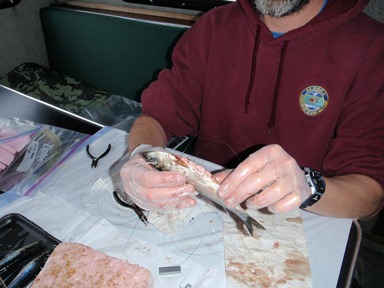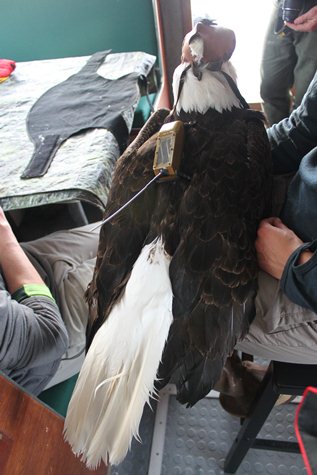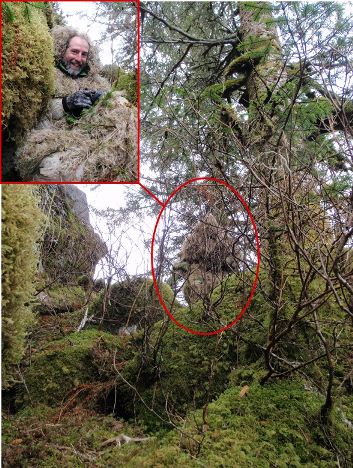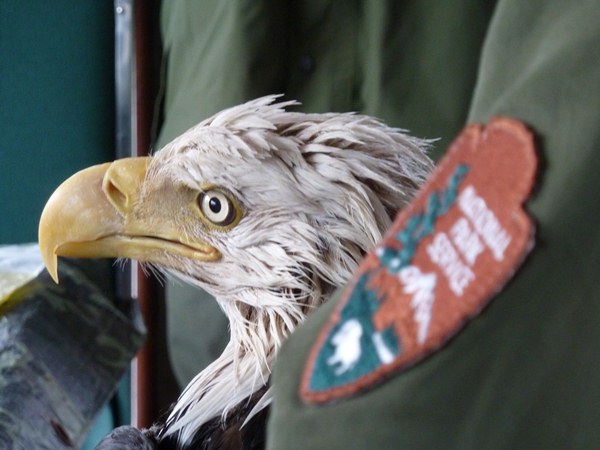Elisa and I giggled as we watched Steve Lewis, U.S. Fish and Wildlife Service (USFWS) raptor biologist, don a hairy disguise and creep into the vegetation. We knew he was trying to conceal himself from the peregrine falcons we were attempting to catch, but anyone passing by would surely think they had just spotted Bigfoot in Kenai Fjords National Park. We motored the skiff away from the cliff where we knew a pair of peregrine falcons was nesting and settled in the boat to wait. Our efforts to trap raptors on this trip consisted of 40% preparation, 50% waiting and 10% excitement.
In May, NPS and USFWS researchers spent nine days along Kenai Fjords coastline conducting a collaborative study of peregrine falcons and bald eagles from the Park's live aboard research vessel, the M/V Serac. Our research consisted of conducting behavioral observations of raptors to determine nesting status, collecting prey remains at nests to examine diet, and trapping birds to attach GPS transmitters to study foraging and migratory movements. Raptors play an important ecological role in the marine nearshore environment of Kenai Fjords as predators of fish and birds, especially seabirds.
The first evening onboard the Serac we spend preparing to catch bald eagles. Elisa and Deb are tasked with making lots and lots of monofilament nooses, a critical component of a noosed-herring bait trap. As they begin making small knots in 12 inch pieces of monofilament line and competing to see who has the biggest pile of completed nooses, Steve and I start prepping the herring. Each noosed-herring is created to give us the best chance of fooling an eagle into taking the bait. The trap consists of the noosed herring attached by a line to a small wooden log that acts as a drag.

Noosed herring bait. Photo: NPS \ Laura Phillips
In the morning the rain is still coming down hard. We all pile into the skiff and start looking through our rain splattered binoculars in search of hungry-looking eagles. We quickly come across a likely candidate stoically perched in a tall spruce, seemingly undisturbed by the rain. We set our trap in front of the eagle and motor a short distance away to watch. We spend the majority of the rest of the day moving traps around, waiting, and trying to stay as warm and dry as possible. Finally, we find an eagle that seems to think our bait looks appetizing. We hold our breath as she stoops in to take the bait off the water. She tries to fly back to land but the nooses do their work. The drag of the log prevents her from taking off and she lands gently in the water. We quickly motor up to the log and Steve pulls the eagle carefully into the boat. Once in the boat, we outfit the bird with a leather hood to keep her calm and booties to keep us safe and head back to the Serac to take measurements and attach the GPS transmitter. We release her in the same location, now sporting a backpack transmitter. She immediately flies back to perch in a spruce tree and to preen her feathers. She also immediately begins to collect location data (see where she went the first four days after capture with Google Earth). We manage to trap and attach transmitters to four bald eagles over the course of the trip, a success rate that makes eagle trapping look easy.

GPS transmitter attached to a bald eagle. Photo: NPS \ Laura Phillips
Unfortunately, the peregrine falcon trapping was not nearly as successful. Most of the methods used to trap falcons require large open spaces to set up nets and to allow falcons an unobstructed path to stoop in on decoys or bait. The steep, treed coastline of Kenai Fjords proved to be extremely challenging terrain for trapping peregrine falcons. The closest we came was on Chat Island, part of the Alaska Maritime National Wildlife Refuge, on the last day of our trip. We set up a great horned owl decoy in front of a large net on the cliff above the nest ledge. Steve donned his shaggy disguise, which now had so many sticks, leaves, and moss attached to it that he really did look like he was part of the landscape, and settled down next to the net to play recordings of a great horned owl and move the stuffed owl back and forth on its perch. We hoped the falcons would be upset enough by the presence of this predator in their territory that they would try to drive it away and in the process get caught in the net above the owl.

Photo: NPS \ Laura Phillips
Steve played the owl call and the female peregrine responded aggressively, screaming her alarm call and stooping repeatedly over the owl decoy. Unfortunately, she flew just above the net, managing to avoid capture. After a few minutes, the falcon must have decided the owl was not very threatening, and she returned to her nest. We spent the rest of the day trying various trapping techniques on the Chat Island pair, but never came any closer to catching one of the birds. Maybe it was too early in the season and the falcons were not feeling very defensive of their nest yet, maybe they saw the net, or maybe they were just too smart for us. One thing I do know, they never suspected that our Sasquatch was really a biologist in disguise.

Photo: NPS \ Deb Kurtz
See where the other 3 eagles went in Google Earth by clicking these links: Eagle 2, Eagle 3, Eagle 4.
